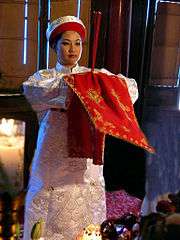Đạo Mẫu
Đạo Mẫu (Vietnamese: [ɗâːwˀ mə̌wˀ], 道母) is the worship of Mother Goddesses which was established in Vietnam in the 16th century.[1][2] While scholars like Ngô Đức Thịnh propose that it represents a systematic mother goddess, Đạo Mẫu draws together fairly disparate beliefs and practices.[3][4][5][6] These include the worship of goddesses such as Thiên Y A Na, The Lady of the Realm (Bà Chúa Xứ), The Lady of the Storehouse (Bà Chúa Kho) and Princess Liễu Hạnh,[7] legendary figures like Âu Cơ, the Trưng Sisters (Hai Bà Trưng), and Lady Triệu (Bà Triệu), as well as the cult of the Four Palaces. Đạo Mẫu is commonly associated with spirit mediumship rituals—known in Vietnam as lên đồng—much as practiced in other parts of Asia, such as Southern China, Myanmar (Mon people) and some community in India... Although the Communist government had initially proscribed the practice of such rituals, deeming them to be superstitions, they relented in 1987, once again legalizing their practice.

The worshipping of the Mother Goddesses contributes to the appreciation of women in society. Recognized by UNESCO, this Vietnamese ritual was inscribed on Representative List in December 2016.[8]
Four Palaces (Tứ Phủ)
The most prominent form of Đạo Mẫu is Four Realms (Tứ Phủ), which worships a hierarchical pantheon of Vietnamese local deities with a strong influence from historical figures, Taoism and Buddhism. Four Realms is the most common in the North. Other forms in different areas have also developed an interference with other local beliefs.
The name literally means "Four Mansions", which includes the four realms Heaven, Highlands, Water and Earth.
Notes
- Asian Ethnology, Volumes 67-68 2008 p.305 "mother goddess religion (Đạo Mẫu)"
- Karen Fjelstad; Thị Hiền Nguyễn (2006). Possessed by the Spirits: Mediumship in Contemporary Vietnamese Communities. SEAP Publications. pp. 38–. ISBN 978-0-87727-141-3.
- Ngô Đức Thịnh,"The Cult of the Female Spirits and the Mother Goddesses 'Mẫu'," Vietnamese Studies 121, no.3 (1996):83-96
- "Đạo Mẫu ở Việt Nam" [The Mother Goddess Religion in Vietnam] (Hà Nội: Nhà Xuất Bản Văn Hóa Thông Tin, 1996)
- "The Pantheon for the Cult of Holy Mothers," Vietnamese Studies 131, no.1 (1999): 20-35
- "The Mother Goddess Religion: Its History, Pantheon, and Practices," in Possessed by the Spirits: Mediumship in Contemporary Vietnamese Communities, ed. Karen Fjelstad and Nguyen Thi Hien. (Ithaca, N.Y.: Cornell Southeast Asia Program, 2006), 19-30.
- Nguyen Quoc Tan, Mother Goddess Liễu Hạnh under the View of Religious Studies, Religious Studies Review Vol. 1, No. 2 – May 2007.
- "UNESCO - Practices related to the Viet beliefs in the Mother Goddesses of Three Realms". ich.unesco.org. Retrieved 2020-07-20.